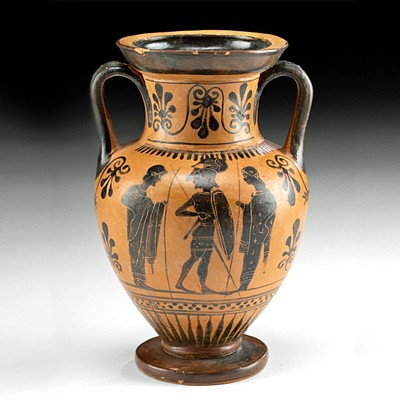Superb Nazca Feather Crown w/ Gold & Electrum Discs
Lot 183a
About Seller
Artemis Gallery
686 S Taylor Ave, Ste 106
Louisville, CO 80027
United States
Selling antiquities, ancient and ethnographic art online since 1993, Artemis Gallery specializes in Classical Antiquities (Egyptian, Greek, Roman, Near Eastern), Asian, Pre-Columbian, African / Tribal / Oceanographic art. Our extensive inventory includes pottery, stone, metal, wood, glass and textil...Read more
Categories
Estimate:
$13,000 - $19,500
Absentee vs Live bid
Two ways to bid:
- Leave a max absentee bid and the platform will bid on your behalf up to your maximum bid during the live auction.
- Bid live during the auction and your bids will be submitted real-time to the auctioneer.
Bid Increments
| Price | Bid Increment |
|---|---|
| $0 | $25 |
| $300 | $50 |
| $1,000 | $100 |
| $2,000 | $250 |
| $5,000 | $500 |
| $10,000 | $1,000 |
| $20,000 | $2,500 |
| $50,000 | $5,000 |
| $100,000 | $10,000 |
| $200,000 | $20,000 |
About Auction
By Artemis Gallery
Mar 9, 2023
Set Reminder
2023-03-09 10:00:00
2023-03-09 10:00:00
America/New_York
Bidsquare
Bidsquare : Exceptional Ancient, Ethnographic, & Fine Art
https://www.bidsquare.com/auctions/artemis-gallery/exceptional-ancient-ethnographic-fine-art-12354
Artemis Gallery info@artemisgallery.com
Artemis Gallery info@artemisgallery.com
- Lot Description
**First Time At Auction**
Pre-Columbian, South coast Peru, Nazca, ca. 200 BCE to 400 CE. This is a stunning crown fit for royalty or an elite person of Nazca society - the headband is woven from cotton or camelid (alpaca or llama) fibers then covered with hundreds of pink-red feathers and massive gold and electrum discs adorn the sides and form the centerpiece. The discs to the side are 81% gold, and the central electrum disc is 50.5% gold and 45% silver, repousse decorated with circular and stippled motifs, the 5-armed spiral perhaps represents the arms of a starfish or other sea creature. Colorful feathers were prized materials in Andean cultures, and worth nearly the same as precious metals. It is possible that live, caged birds as well as their plucked feathers were imported from the lower altitudes to supply this demand. Size: 9.75" Diameter x 2.75" W (24.8 cm x 7 cm); 11.75" H (29.8 cm) on included custom stand; gold quality: 81% to 81.5% (equivalent to 19K+) ; electrum quality: 50.5% (equivalent to 12k+) gold, 45% silver.
This is a very early example of a feathered item; the oldest known date to around 350 to 200 BCE, found in elite burials in the Ocucaje Basin of the Ica Valley in southern coastal Peru. These burials contained ceramics, baskets, gold ornaments, musical instruments, and weapons, as well as many beautiful woven and patterned textiles. Organic materials are incredibly preserved in this region by the dry desert environment, allowing us to see incredible artifacts like this one today. Researchers believe the Ocucaje and nearby Paracas burials (both are commonly referred to as Paracas) represent the rise of a new religion, one that required new ritual paraphernalia - notably, feathered objects. For example, an Ocucaje grave excavated by the famous German archaeologist Max Uhle in 1901 contained a "fan-like plume" made of macaw feathers and placed behind the head of the mummy. The feathers may have come from a local bird, a parakeet; other feathered items found in nearby graves came from parrots or macaws, who would have been traded from the Amazon into the highlands of Peru. The coloration and similar museum collects suggest that these feathers could be flamingo.
Provenance: private Hawaii collection, acquired 2000 to 2010
All items legal to buy/sell under U.S. Statute covering cultural patrimony Code 2600, CHAPTER 14, and are guaranteed to be as described or your money back.
A Certificate of Authenticity will accompany all winning bids.
We ship worldwide and handle all shipping in-house for your convenience.
#177500Missing feathers in some areas. Minor fraying to cotton cords at the tips. Tiny tears and indentations to gold discs, central disc has small adhesive to stabilizes the tears. Overall excellent condition.Condition
- Shipping Info
-
All shipping is handled in-house for your convenience. Your invoice from Artemis Gallery will include shipping calculation instructions. If in doubt, please inquire BEFORE bidding for estimated shipping costs for individual items.
-
- Buyer's Premium



 EUR
EUR CAD
CAD AUD
AUD GBP
GBP MXN
MXN HKD
HKD CNY
CNY MYR
MYR SEK
SEK SGD
SGD CHF
CHF THB
THB
















